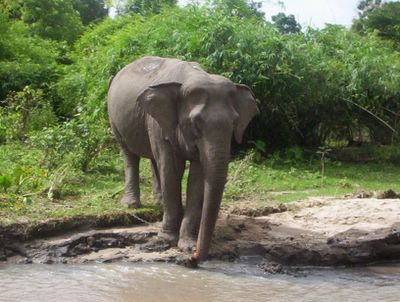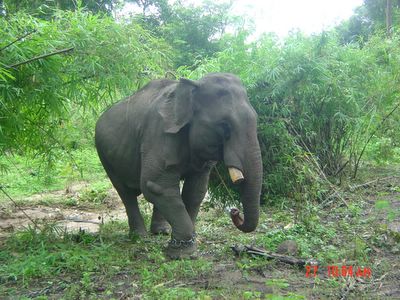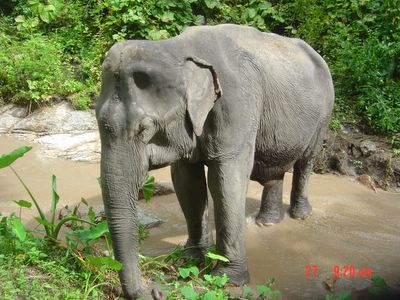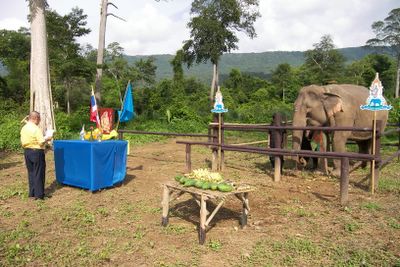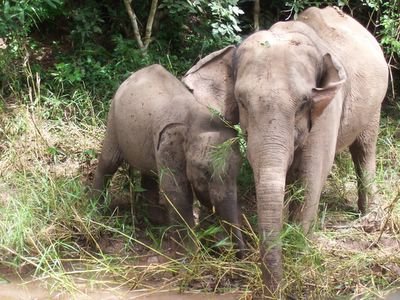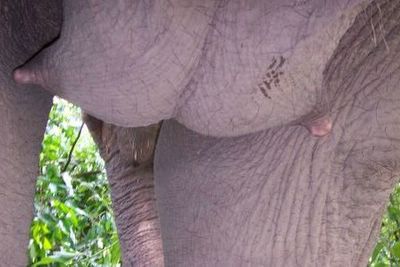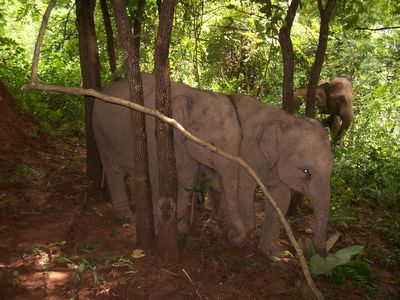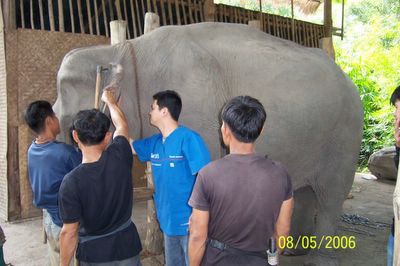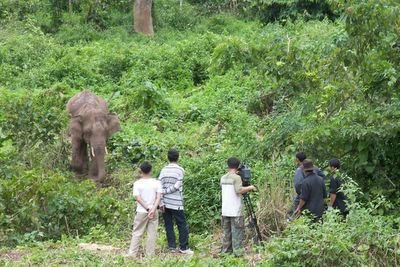 The macro (back hoe) is digging a new channel to change the water direction at the area behind the Mae Pon camp, Lampang to prevent erosion of the bank and flooding of the Foundation's camp office and the Papla due to the heavy rains.
รถแม็คโครกำลังขุดเพื่อเปลี่ยนทิศทางน้ำบริเวณหลังแคมป์แม่ป๋อน ลำปาง
The macro (back hoe) is digging a new channel to change the water direction at the area behind the Mae Pon camp, Lampang to prevent erosion of the bank and flooding of the Foundation's camp office and the Papla due to the heavy rains.
รถแม็คโครกำลังขุดเพื่อเปลี่ยนทิศทางน้ำบริเวณหลังแคมป์แม่ป๋อน ลำปาง
Our Mission is to realize the vision of Her Majesty Queen Sirikit, The Queen Mother by reintroducing domesticated elephants into the wild, restoring wild habitats with indigenous plants and wildlife, researching and propagating knowledge about elephants and promoting appropriate management of elephants in Thailand for their long-term survival.
Thursday, August 31, 2006
 The macro (back hoe) is digging a new channel to change the water direction at the area behind the Mae Pon camp, Lampang to prevent erosion of the bank and flooding of the Foundation's camp office and the Papla due to the heavy rains.
รถแม็คโครกำลังขุดเพื่อเปลี่ยนทิศทางน้ำบริเวณหลังแคมป์แม่ป๋อน ลำปาง
The macro (back hoe) is digging a new channel to change the water direction at the area behind the Mae Pon camp, Lampang to prevent erosion of the bank and flooding of the Foundation's camp office and the Papla due to the heavy rains.
รถแม็คโครกำลังขุดเพื่อเปลี่ยนทิศทางน้ำบริเวณหลังแคมป์แม่ป๋อน ลำปาง
Saturday, August 26, 2006
Monday, August 21, 2006
Elephant Breasts

Another similarity between humans and elephants: Of all the living things on this earth, the female elephant's pair of breasts is remarkably the most similar to the human female breasts. A newly born calf is able to suckle the milk from the breasts with his mouth and will continue to breast-feed for at least 2 years.
Friday, August 18, 2006
Thursday, August 17, 2006
Wednesday, August 16, 2006
Seedor Boonchoo
 We are very sadden by the news that Seedor Boonchoo died at Doi Pha Muang Wildlife Sanctuary. In photo the Ajarn prays to the spirit of Seedor Boonchoo and that he enjoys freedom from his earthly body. Vet Taweepoke and associates perform the autopsy in the afternoon to determine cause of death.
ทางมูลนิธิฯเสียใจอย่างสุดซึ้งกับการจากไปของสีดอบุญชู ณ เขตรักษาพันธุ์สัตว์ป่าดอยผาเมือง จ.ลำปาง ในภาพอาจารย์กำลังสวดมนต์เพื่อให้ดวงวิญญาณของสีดอบุญชูไปสู่สุคติ นายสัตวแพทย์ทวีโภค นายสัตว์แพทย์ที่ปรึกษาของมูลนิธิฯและทีมสัตวแพทย์กำลังผ่าพิสูจน์หาสาเหตุการตายว่าช้างล้มเนื่องจากสาเหตุอะไร
We are very sadden by the news that Seedor Boonchoo died at Doi Pha Muang Wildlife Sanctuary. In photo the Ajarn prays to the spirit of Seedor Boonchoo and that he enjoys freedom from his earthly body. Vet Taweepoke and associates perform the autopsy in the afternoon to determine cause of death.
ทางมูลนิธิฯเสียใจอย่างสุดซึ้งกับการจากไปของสีดอบุญชู ณ เขตรักษาพันธุ์สัตว์ป่าดอยผาเมือง จ.ลำปาง ในภาพอาจารย์กำลังสวดมนต์เพื่อให้ดวงวิญญาณของสีดอบุญชูไปสู่สุคติ นายสัตวแพทย์ทวีโภค นายสัตว์แพทย์ที่ปรึกษาของมูลนิธิฯและทีมสัตวแพทย์กำลังผ่าพิสูจน์หาสาเหตุการตายว่าช้างล้มเนื่องจากสาเหตุอะไรMonday, August 14, 2006
 Khun Chookiat points to the man-made (Or Bor Tor) water reservior near Baan Nong Hoi, Kanchanaburi where a herd of 27-30 wild elephants in the Salah Pra Wildlife Sanctuary come for water constantly since their access to the River Kwai has been cut off and there is lack of flowing water in the Sanctuary. We talked by phone with Vet Samart Prasitphol of the Livestock Department. He is of the opinion that these elephants are thin and may lack some nutrients. He has recently collected samples from natural salt licks, from ones that elephants no longer use and from those still used, for analysis. He said that the results will be back in three weeks. The Foundation will cooperate and support him in this research so that we can develop the appropriate salt lick formula for the elephants. We have only been using salt in our mixture so far.
คุณชูเกียรติชี้สระน้ำที่มุษย์จัดเตรียมไว้ให้ใกล้บริเวณบ้านหนองหอย จ.กาญจนบุรีเป็นที่อยู่อาศัยของโขลงช้างป่าจำนวน 27-30 ตัว ณ เขตรักษาพันธุ์สัตว์ป่าสลักพระ ซึ่งไม่มีการไหลของกระแสน้ำเนื่องจากแม่น้ำแควไหลผ่าน ทางมูลนิธิฯได้ปรึกษากับนายสัตวแพทย์สามารถ ประสิทธิผล กรมปศุสัตว์ เขาเห็นว่าช้างเหล่านี้ร่างกายซูบผอมและขาดสารอาหาร ดังนั้นเขาได้เก็บตัวอย่างโป่งเทียมหรือเกลือเสริมอาหารสำหรับช้าง เพื่อไปวิจัยว่าประกอบด้วยสารอาหารอะไรบ้าง และคุณสามารถแจ้งผลการทำวิจัยเรื่องโป่งเทียมนี้กับมูลนิธิฯ ซึ่งทางมูลนิธิฯพร้อมให้ความร่วมมือในการพัฒนาอาหารเสริมสำหรับช้าง
Khun Chookiat points to the man-made (Or Bor Tor) water reservior near Baan Nong Hoi, Kanchanaburi where a herd of 27-30 wild elephants in the Salah Pra Wildlife Sanctuary come for water constantly since their access to the River Kwai has been cut off and there is lack of flowing water in the Sanctuary. We talked by phone with Vet Samart Prasitphol of the Livestock Department. He is of the opinion that these elephants are thin and may lack some nutrients. He has recently collected samples from natural salt licks, from ones that elephants no longer use and from those still used, for analysis. He said that the results will be back in three weeks. The Foundation will cooperate and support him in this research so that we can develop the appropriate salt lick formula for the elephants. We have only been using salt in our mixture so far.
คุณชูเกียรติชี้สระน้ำที่มุษย์จัดเตรียมไว้ให้ใกล้บริเวณบ้านหนองหอย จ.กาญจนบุรีเป็นที่อยู่อาศัยของโขลงช้างป่าจำนวน 27-30 ตัว ณ เขตรักษาพันธุ์สัตว์ป่าสลักพระ ซึ่งไม่มีการไหลของกระแสน้ำเนื่องจากแม่น้ำแควไหลผ่าน ทางมูลนิธิฯได้ปรึกษากับนายสัตวแพทย์สามารถ ประสิทธิผล กรมปศุสัตว์ เขาเห็นว่าช้างเหล่านี้ร่างกายซูบผอมและขาดสารอาหาร ดังนั้นเขาได้เก็บตัวอย่างโป่งเทียมหรือเกลือเสริมอาหารสำหรับช้าง เพื่อไปวิจัยว่าประกอบด้วยสารอาหารอะไรบ้าง และคุณสามารถแจ้งผลการทำวิจัยเรื่องโป่งเทียมนี้กับมูลนิธิฯ ซึ่งทางมูลนิธิฯพร้อมให้ความร่วมมือในการพัฒนาอาหารเสริมสำหรับช้างSaturday, August 12, 2006
 On the Occasion of H.M. the Queen's Birthday, ITV Channel TV broadcasts a news coverage of the Queen's work on elephant reintroduction. A much longer TV Special will be aired later on.
ข่าวไอทีวีถ่ายทำรายการและเผยแพร่ภาพกิจกรรมต่างๆและช้างในความดูแลของมูลนิธิฯ เขตรักษาพันธุ์สัตว์ป่าซับลังกา เนื่องในวโรกาสเฉลิมพระชนมพรรษา สมเด็จพระนางเจ้าฯ พระบรมราชินีนาถ
On the Occasion of H.M. the Queen's Birthday, ITV Channel TV broadcasts a news coverage of the Queen's work on elephant reintroduction. A much longer TV Special will be aired later on.
ข่าวไอทีวีถ่ายทำรายการและเผยแพร่ภาพกิจกรรมต่างๆและช้างในความดูแลของมูลนิธิฯ เขตรักษาพันธุ์สัตว์ป่าซับลังกา เนื่องในวโรกาสเฉลิมพระชนมพรรษา สมเด็จพระนางเจ้าฯ พระบรมราชินีนาถ Khun Pantana and staff at Doi Pha Muang Lampang display their loyalty and honour Her Majesty Queen Sirikit on the occasion of her royal birthday.
คุณพันธุ์ธนา และเจ้าหน้าที่ภาคสนาม มูลนิธิคืนช้างสู่ธรรมชาติ เขตรักษาพันธุ์สัตว์ป่าดอยผาเมือง ร่วมกันถวายพระพรแด่สมเด็จพระนางเจ้าฯ พระบรมราชินีนาถ เนื่องในวันเฉลิมพระชนมพรรษา 12 สิงหาคม 2549
Khun Pantana and staff at Doi Pha Muang Lampang display their loyalty and honour Her Majesty Queen Sirikit on the occasion of her royal birthday.
คุณพันธุ์ธนา และเจ้าหน้าที่ภาคสนาม มูลนิธิคืนช้างสู่ธรรมชาติ เขตรักษาพันธุ์สัตว์ป่าดอยผาเมือง ร่วมกันถวายพระพรแด่สมเด็จพระนางเจ้าฯ พระบรมราชินีนาถ เนื่องในวันเฉลิมพระชนมพรรษา 12 สิงหาคม 2549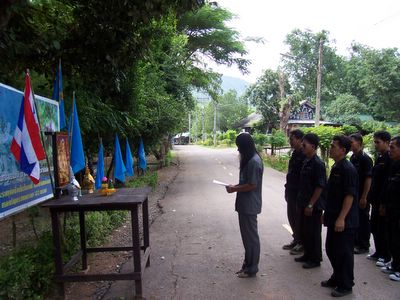 Khun Parichat and staff at Sublangka Wildlife Sanctuary display their loyalty and honour Her Majesty Queen Sirikit on the occasion of her royal birthday.
คุณปาริชาติและเจ้าหน้าที่ภาคสนาม มูลนิธิคืนช้างสู่ธรรมชาติ เขตรักษาพันธุ์สัตว์ป่าซับลังกา จ.ลพบุรี ร่วมกันถวายพระพรแด่สมเด็จพระนางเจ้าฯ พระบรมราชินีนาถ เนื่องในวันเฉลิมพระชนมพรรษา 12 สิงหาคม 2549
Khun Parichat and staff at Sublangka Wildlife Sanctuary display their loyalty and honour Her Majesty Queen Sirikit on the occasion of her royal birthday.
คุณปาริชาติและเจ้าหน้าที่ภาคสนาม มูลนิธิคืนช้างสู่ธรรมชาติ เขตรักษาพันธุ์สัตว์ป่าซับลังกา จ.ลพบุรี ร่วมกันถวายพระพรแด่สมเด็จพระนางเจ้าฯ พระบรมราชินีนาถ เนื่องในวันเฉลิมพระชนมพรรษา 12 สิงหาคม 2549Friday, August 11, 2006
Elephant and Water
Elephants have a propensity for water. They love to bath and play in creeks and steams. Baby elephants learn to swim at an early age. Elephants can stay submerged for some time using only their trunk as a snorkel.
Elephants require a large quantity of water on a daily basis. They drink water by sucking water into their trunk (up to 5 liters) then discharging the accumulated water from their trunk into their mouth.
Elephants prefer to drink from clean running streams only. Where by necessity the water source is stale during the dry season, we observe them using the trunk to dig a hole nearby the stagnant pool or stream where the elephant will find a clean source of water.
As our observation of Plai Chumpol taught us, elephants can get their daily water requirement by eating plants that contain a lot of water. Plai Chumpol chewed and ate a small banana tree and then sprayed a lot of water from his trunk so as to show us how much water was contained in that banana tree. I will make closer observation because I am not sure if he had removed the extracted water from his mouth with the trunk first before spraying or if he was able to move the extracted water directly inside his mouth to his trunk.
Our field staff told us that during the drought the elephants will get most of their daily water requirement from the vegetation they eat.
In 2004 we were concerned that the elephants would not have enough water if their was a drought in 2005 so the Foundation spent over Baht 500,000 to have water holes and ponds dug. In 2005 we were sad to find that the man-made water sources could not hold water and were dry. To our amazement, we found that the elephants innately know where to find water. Along the dry creek they would use their trunk and tusks to dig water holes that where not only sufficient for themselves but also for the other wildlife in the forest. Elephant footprints provide excellent water receptacles for other wildlife after rains. Wherever the elephants walk in the forest the other wildlife benefit. We observed butterfies to wild boar drinking from water in the elephant footprints.
ธรรมชาติของช้างเป็นสัตว์ขี้ร้อน ชอบเล่นโคลนและเล่นน้ำบริเวณแหล่งน้ำตามธรรมชาติ ได้แก่ ห้วย หนอง ลำธาร บึง ช้างสามารถว่ายน้ำได้เก่งทุกตัวโดยไม่ต้องหัด สามารถว่ายน้ำได้ทน โดยเท้าไม่แตะพื้น หากแม่ช้างที่มีลูกช้างน้อยด้วย แม่จะให้ลูกเกาะหรือพยุงไปตามข้างไหล่ของแม่หรือเอางวงคอยหนุนพยุงลูกไม่ให้จมน้ำช้างสามารถดำน้ำได้นานและจะชูงวงขึ้นพ้นน้ำมาหายใจอีกทีหนึ่ง โดยปกติช้างดื่มน้ำปริมาณมาก ช้างจะดื่มน้ำโดยใช้งวงดูดพ่นน้ำเข้าปาก น้ำสะอาดสำหรับช้างมีไว้เพื่อทำความสะอาดร่างกายและดื่มกิน โดยทั่วไปช้างมักดื่มน้ำในขณะกำลังอาบน้ำไปพร้อมๆกัน แต่เมื่อไรที่ถึงฤดูแล้งช้างจะใช้งวงขุดเป็นหลุมเพื่อเป็นที่กักเก็บน้ำที่สะอาด จากการสังเกตของพลายชุมพล ช้างนั้นดื่มน้ำทุกวันจากพืชหรือต้นไม้ซึ่งมีส่วนประกอบน้ำเป็นส่วนใหญ่ และพลายชุมพลกินต้นกล้วยขนาดเล็กและหลังจากนั้นก็พ่นน้ำออกมาทางงวงเพื่อให้เห็นว่ามีปริมาณน้ำเท่าไร และทางมูลนิธิฯ จะทำการวิจัยต่อไปว่าช้างดูดน้ำจากพืชแล้วด้วยงวงก่อนที่จะพ่นน้ำออกมาหรือว่าดูดน้ำจากพืชแล้วด้วยปากแล้วใช้งวงพ่นน้ำออกมา เจ้าหน้าที่ภาคสนามบอกพวกเราว่า ในฤดูแล้งช้างจะได้รับน้ำจากพืชที่พวกเขากิน ในปี พ.ศ. 2547 ที่ผ่านมาทางมูลนิธิเห็นว่าปริมาณน้ำอาจไม่เพียงพอสำหรับช้างที่อยู่ในความดูแลของมูลนิธิฯ ดังนั้นทางมูลนิธิจึงได้จัดทำสระน้ำขึ้นสำหรับเป็นแหล่งน้ำแต่ปริมาณน้ำอาจยังไม่เพียงพอสำหรับ ปี พ.ศ. 2548 แต่เป็นที่น่าแปลกใจ ทางมูลนิธิฯ พบว่าช้างสามารถหาแหล่งน้ำได้โดยสัญชาติญาณ เพราะว่าตามแหล่งน้ำที่แห้งขอด ช้างจะใช้งาและงวงขุดหลุมเพื่อเป็นบ่อน้ำเล็กสำหรับเป็นแหล่งน้ำของเขาเองและสำหรับสัตว์ป่าอื่นอีกด้วย เช่น ผีเสื้อและหมูป่า รอยเท้าของช้างตามแหล่งน้ำที่ช้างสร้างขึ้นจะเป็นแหล่งน้ำสำหรับสัตว์ป่าอื่นได้เป็นอย่างดี
Wednesday, August 09, 2006
 The exhibition " POH-CHANG : ARTISTS FOR ELEPHANT " at The Queen's Gallery on 8 August 2006 is opened by DR.Sumet Tantivejkul, Chairman of Elephant Reintroduction Foundation.
ดร.สุเมธ ตันติเวชกุล ประธานมูลนิธิคืนช้างสู่ธรรมชาติเป็นประธานเปิดงานนิทรรศการ "เพาะช่าง : ศิลปินเพื่อช้าง" ณ หอศิลป์ สมเด็จพระนางเจ้าฯพระบรมราชินีนาถ เมื่อวันที่ 8 สิงหาคม พ.ศ. 2549
The exhibition " POH-CHANG : ARTISTS FOR ELEPHANT " at The Queen's Gallery on 8 August 2006 is opened by DR.Sumet Tantivejkul, Chairman of Elephant Reintroduction Foundation.
ดร.สุเมธ ตันติเวชกุล ประธานมูลนิธิคืนช้างสู่ธรรมชาติเป็นประธานเปิดงานนิทรรศการ "เพาะช่าง : ศิลปินเพื่อช้าง" ณ หอศิลป์ สมเด็จพระนางเจ้าฯพระบรมราชินีนาถ เมื่อวันที่ 8 สิงหาคม พ.ศ. 2549Tuesday, August 08, 2006
Elephant Digestive System
The elephant's digestive system is a fairly simple matter but big in purpose. The cocktail shaker shaped stomach is vertically positioned and leads to a fairly long set of intestines of over 30 meters in length (maximum 35 meters). The elephant feeds on various vegetation, chewing them with its teeth, storing some in the stomach and then processes most of its intake as compost and seeds for the forest, absorbing only a fraction for its own existence. It establishes the elephant as a super keystone species assigned with the task of fertilizing and growing the forests. Certain seeds will only germinate after passing through an elephant.
For the naive and unknowing casual observer, the elephant remains a big beast that eats all the time and too much. In real fact, the elephant in the wild is constantly working dedicatedly in its task. A captive elephant has little chance to do so.
ระบบการทางเดินอาหารอาหารของช้าง
ช้างเป็นสัตว์กระเพาะเดี่ยวที่กินพืชเป็นอาหารเพียงอย่างเดียว ไม่ได้เป็นกระเพาะอาหาร แบบสัตว์เคี้ยวเอื้อง ขนาดของกระเพาะอาหารมีรูปร่างทรงกระบอกขยายได้ถึง 30 เมตรจนถึง35 เมตรเนื่องจากช้างไม่มีกระเพาะพิเศษ สำหรับเก็บอาหารไว้สำรองแล้ว สำรอกออกมาเคี้ยวเอื้องในยามว่าง เหมือนดังเช่นวัวควาย แต่ช้างก็มีวิธีเก็บสำรองอาหารไว้กินในระหว่างเดินทาง หรือระหว่างทำงาน เช่น เอางวงกำหญ้าไว้ในขณะเดินทาง หรือเอาหญ้าและอาหารเหน็บไว้ที่ซอกงาของมันและมูลช้างยังมีเมล็ดพืช ชนิดต่างๆที่ช้างกินเข้าไป ซื่งเมล็ดพืชเหล่านี้พร้อมที่จะ เติบโตเป็นต้นใหม่ได้ เมื่อได้รับความชุ่มชื้นจากน้ำและอากาศ
 Seedor Boonchoo's dung, which is rough and green, reflects either a deterioration of his teeth or his digestive system or both. However, even in this rough stage the dung is still very good compost for the forest.
มูลช้างของสีดอบุญชูมีสีเขียวและมีลักษณะหยาบเนื่องจากฟันและระบบการย่อยอาหารไม่ดี อย่างไรก็ตามมูลช้างในการตรวจสอบเบื้องต้นประกอบด้วยพืชพันธุ์ที่อุดมสมบรูณ์
Seedor Boonchoo's dung, which is rough and green, reflects either a deterioration of his teeth or his digestive system or both. However, even in this rough stage the dung is still very good compost for the forest.
มูลช้างของสีดอบุญชูมีสีเขียวและมีลักษณะหยาบเนื่องจากฟันและระบบการย่อยอาหารไม่ดี อย่างไรก็ตามมูลช้างในการตรวจสอบเบื้องต้นประกอบด้วยพืชพันธุ์ที่อุดมสมบรูณ์
Elephant Teeth ฟันของช้าง
The Asian elephant teeth is designed to handle forest matter whereas the African elephant teeth is for browsing. The Asian elephant has about 24 molars in its livespan. Two molars on each side of its mouth. Each molar can have 20 horizontal and parallel ridges. The elephant will have six sets of teeth during its life and maybe a seventh set if it is still active. Elephant dentation is roughly outlined below:
Molar Molar Appearance Molar Loss
I birth 2 years
II birth 6 years
III 1 year 13-15 years
IV 6 years 28 years
V 18 years 43 years
VI 30 years 65+ years
I am not sure if the above dentation timetable is correct for the Asian elephant, but it will serve as a guideline.
Because of its long and hard work in reforestation and habitat engineering the elephant needs replacement teeth and it has been provided with six sets and maybe seven for its lifetime work. When its teeth are gone, the elephant will die a natural death from starvation. We hope to use Seedor Boonchoo as a study for elephant teeth since he is old (70 plus) and he seems to be on his sixth set of molars.
The Asian elephant teeth is designed to handle forest matter whereas the African elephant teeth is for browsing. The Asian elephant has about 24 molars in its livespan. Two molars on each side of its mouth. Each molar can have 20 horizontal and parallel ridges. The elephant will have six sets of teeth during its life and maybe a seventh set if it is still active. Elephant dentation is roughly outlined below:Molar Molar Appearance Molar LossI birth 2 yearsII birth 6 yearsIII 1 year 13-15 yearsIV 6 years 28 yearsV 18 years 43 yearsVI 30 years 65+ yearsI am not sure if the above dentation timetable is correct for the Asian elephant, but it will serve as a guideline.Because of its long and hard work in reforestation and habitat engineering the elephant needs replacement teeth and it has been provided with six sets and maybe seven for its lifetime work. When its teeth are gone, the elephant will die a natural death from starvation. We hope to use Seedor Boonchoo as a study for elephant teeth since he is old (70 plus) and he seems to be on his sixth set of molar
ช้างสายพันธุ์เอเชียอาศัยอยู่ตามป่าดังนั้นขนาดของฟันจึงออกแบบสำหรับพืชที่อยู่ตามป่า ฟันจึงมีลักษณะเป็นแผ่นและมีสันร่องเป็นรูปวงรีซ้อนกัน
ขณะที่ฟันของช้างสายพันธุ์แอฟริกาใช้สำหรับการแทะเล็ม (ช้างแอฟริกาจะมีสันร่องเป็นรูปสี่เหลี่ยมขนมเปียกปูน)
ฟันของช้างสายพันธุ์เอเชีย ลักษณะการงอกของฟันช้างจะมีการงอกขึ้นมาในแนวระนาบ ฟันชุดใหม่จะดันฟันชุดเก่าไปทางด้านหน้า แทนที่จะงอกขึ้นมาจากด้านล่างเช่นเดียวกับในสัตว์อื่น ช้างมีสันร่องฟันจำนวน 24 สันร่อง ช้างมีฟันทั้งหมด 6 ชุด เป็นฟันน้ำนม (Premolars) มี 3 ชุด และฟันแท้ (Molars) ฟันกรามแท้ของช้างมี 3 ชุด ฟันน้ำนมชุดแรกจะติดมากับลูกตั้งแต่เกิด ฟันช้างประกอบด้วย ฟันตัด(งา) มี 1 คู่บน ฟันกรามล่างมี 6 ซี่ ฟันกรามบน 6 ซี่ เขี้ยวไม่มี สันร่องนี้สามารถบอกอายุของช้างได้ ฟันชุดใหม่จะงอกมาจากด้านในแล้วดันชุดเก่าหลุดออกไป
ช้างมีฟันทั้งหมด 6 ชุด ดังนี้
1. ฟันน้ำนมชุดที่ 1 ฟันน้ำนมชุดแรกของช้างจะปรากฎให้เห็นตั้งแต่เมื่อลูกช้างแรกเกิด เมื่อลูกช้างอายุได้ประมาณ 2 ปี ฟันน้ำนมชุดแรกนี้จะหลุดไป
2. ฟันน้ำนมชุดที่ 2 จะขึ้นมาแทนที่ฟันน้ำนมชุดแรกที่หลุดไป จะมีสันร่องฟันจำนวน 8 สันร่อง และจะหลุดไปเมื่อช้างมีอายุประมาณ 6 ปี
3. ฟันน้ำนมชุดที่ 3 จะขึ้นมาแทนที่ฟันน้ำนมชุดที่ 2 ที่หลุดไป จะมีสันร่องฟันจำนวน 12 สันร่อง จะหลุดไปเมื่ออายุประมาณ 13 – 15 ปี
4. ฟันแท้ชุดที่ 1 นับว่าเป็นฟันชุดที่ 4 ของช้าง มีสันร่องฟันจำนวน 12 ร่อง อายุเริ่ม 6 ปี จะหลุดไปเมื่อช้างมีอายุประมาณ 28 ปี
5. ฟันแท้ชุดที่ 2 นับเป็นฟันชุดที่ 5 ของช้าง มีสันร่องฟันจำนวน 16 สันร่อง อายุเริ่ม 18 จะหลุดไปเมื่อช้างอายุประมาณ 43 ปี
6. ฟันแท้ชุดที่ 3 เป็นฟันกรามชุดสุดท้ายของช้าง มีสันร่องฟันจำนวน 24 สันร่อง อายุเริ่ม 30 จะหลุดไปเมื่อช้างอายุประมาณ 65 ปี เมื่ออายุมากๆ
อาจมีได้ถึง 27 สันร่อง มีขนาดใหญ่กว่าฟันทุกชุด และช้างจะใช้ฟันชุดนี้ไปจนกระทั่งถึงช่วงสุดท้ายของชีวิต
พวกเราหวังว่าสีดอบุญชูเป็นตัวอย่างของฟันแท้ชุดสุดท้ายเนื่องจากเขามีอายุถึง 70 ปีแล้ว
Monday, August 07, 2006
 We ask that Subin takes a photo of Seedor Boonchoo's teeth. Seems to be quite a struggle as Seedor Boonchoo is reluctant. Mor Taweepoke is of the opinion that he is on his sixth set of molars.
คุณสุบินเจ้าหน้าที่ภาคสนาม ณ เขตรักษาพันธุ์สัตว์ป่าดอยผาเมือง จ.ลำปางถ่ายรูปฟันของสีดอบุญชู หมอทวีโภคกล่าวว่าสีดอบุญชูมีฟันกรามถึง 6 ชุด
We ask that Subin takes a photo of Seedor Boonchoo's teeth. Seems to be quite a struggle as Seedor Boonchoo is reluctant. Mor Taweepoke is of the opinion that he is on his sixth set of molars.
คุณสุบินเจ้าหน้าที่ภาคสนาม ณ เขตรักษาพันธุ์สัตว์ป่าดอยผาเมือง จ.ลำปางถ่ายรูปฟันของสีดอบุญชู หมอทวีโภคกล่าวว่าสีดอบุญชูมีฟันกรามถึง 6 ชุด
 Seedor Boonchoo is brought in for a check up by Mor Taweepoke. He seems to be improving from the special care, vitamins, and supplements given to him.
หมอทวีโภค สัตวแพทย์ที่ปรึกษาของมูลนิธิคืนช้างสู่ธรรมชาติกำลังตรวจสุขภาพสีดอบุญชูซึ่งเป็นช้างที่อยู่ในความดูแลของมูลนิธิฯ สีดอบุญชูได้รับการดูแลรักษาอย่างดีพร้อมทั้งเสริมอาหารจำพวกวิตามินและยาบำรุงสุขภาพ
Seedor Boonchoo is brought in for a check up by Mor Taweepoke. He seems to be improving from the special care, vitamins, and supplements given to him.
หมอทวีโภค สัตวแพทย์ที่ปรึกษาของมูลนิธิคืนช้างสู่ธรรมชาติกำลังตรวจสุขภาพสีดอบุญชูซึ่งเป็นช้างที่อยู่ในความดูแลของมูลนิธิฯ สีดอบุญชูได้รับการดูแลรักษาอย่างดีพร้อมทั้งเสริมอาหารจำพวกวิตามินและยาบำรุงสุขภาพ
Friday, August 04, 2006
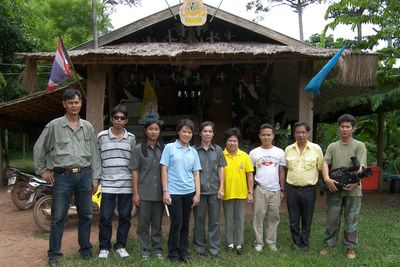 ITV team come to Sublangka Wildlife Sanctuary to make TV Special program presenting the Foundation's work in elephant conservation which will be aired on August 12 , celebrating H.M. Queen Sirikit's Birthday at 9:15 PM prime time.
นักข่าวไอทีวีมาถึงเขตรักษาพันธุ์สัตว์ป่าซับลังกาเพื่อถ่ายทำรายการและเผยแพร่ภาพกิจกรรมต่างๆและช้างในความดูแลของมูลนิธิ รายการนี้จะออกอากาศวันที่ 12 สิงหาคม เวลา 21.15 น. เนื่องในวโรกาสเฉลิมพระชนมพรรษา สมเด็จพระนางเจ้าสิริกิติ์ พระบรมราชินีนาถ
ITV team come to Sublangka Wildlife Sanctuary to make TV Special program presenting the Foundation's work in elephant conservation which will be aired on August 12 , celebrating H.M. Queen Sirikit's Birthday at 9:15 PM prime time.
นักข่าวไอทีวีมาถึงเขตรักษาพันธุ์สัตว์ป่าซับลังกาเพื่อถ่ายทำรายการและเผยแพร่ภาพกิจกรรมต่างๆและช้างในความดูแลของมูลนิธิ รายการนี้จะออกอากาศวันที่ 12 สิงหาคม เวลา 21.15 น. เนื่องในวโรกาสเฉลิมพระชนมพรรษา สมเด็จพระนางเจ้าสิริกิติ์ พระบรมราชินีนาถ
Subscribe to:
Posts (Atom)


